Potatoes are one of the most popular foods worldwide, beloved for their versatility and ability to create a wide range of delicious dishes. From crispy golden French fries and creamy mashed potatoes to savory potato stews, potatoes can satisfy a variety of taste preferences with their unique flavor and texture.
So, how can you grow the best-tasting potatoes? Beyond knowing how to fertilize and water properly, it's crucial to understand how to prevent and manage common potato diseases. Growing healthy potatoes not only enhances their flavor but also boosts yield, ensuring every meal features delicious potatoes.
In the following article, I'll share some practical tips to help you cultivate top-quality potatoes and avoid common potato diseases. Let’s explore how to elevate your potato growing game to the next level!

Symptoms of Nitrogen Deficiency in Potatoes
Potato plants become short, grow slowly, and exhibit weak growth. The stems are thin and elongated with few branches, and the growth is upright.
Symptoms generally start with older leaves, which gradually age, become small, and turn pale green. The edges of the smaller leaves in the middle and lower parts turn yellow, curl upward, and fall off early, with the base of the leaves turning yellow.
Most symptoms appear before flowering. By late growth stages, the edges of the lower leaves completely lose their green color, become shriveled, and may sometimes appear scorched. The leaves may also fall off.
The tubers do not expand properly, and in severe cases, the entire plant's leaves curl upward.
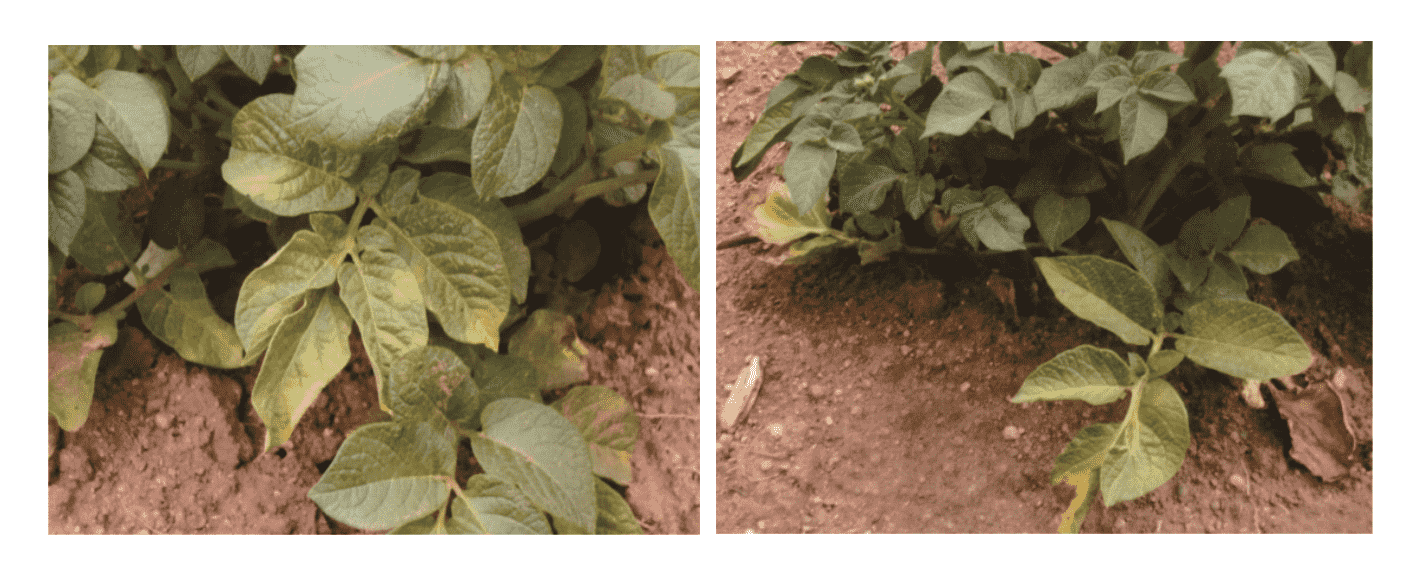
Causes of Nitrogen Deficiency in Potatoes
Nitrogen deficiency often occurs in sandy soils with low organic matter content and acidity levels that inhibit nitrification. It is also common in soils that are thin, poorly managed, and lacking in nutrients, or where there is heavy weed infestation.
Prevention and Correction Measures for Nitrogen Deficiency
In production, it is recommended to use compost made with enzyme-treated materials or well-rotted organic fertilizers, and to adopt formula-based fertilization techniques. When nitrogen deficiency is detected, immediately apply fermented human manure or mix urea or ammonium bicarbonate into 10-15 times its volume of well-rotted organic fertilizer and apply it to the sides of the potato plants. Cover with soil and water thoroughly. Additionally, 15-20 days after planting, combine the application with seedling fertilizer by applying 5 kg of ammonium sulfate or 750-1000 kg of human manure per acre. After 40 days, apply a top-dressing fertilizer, using 10 kg of ammonium sulfate or 1000-1500 kg of human manure per acre.
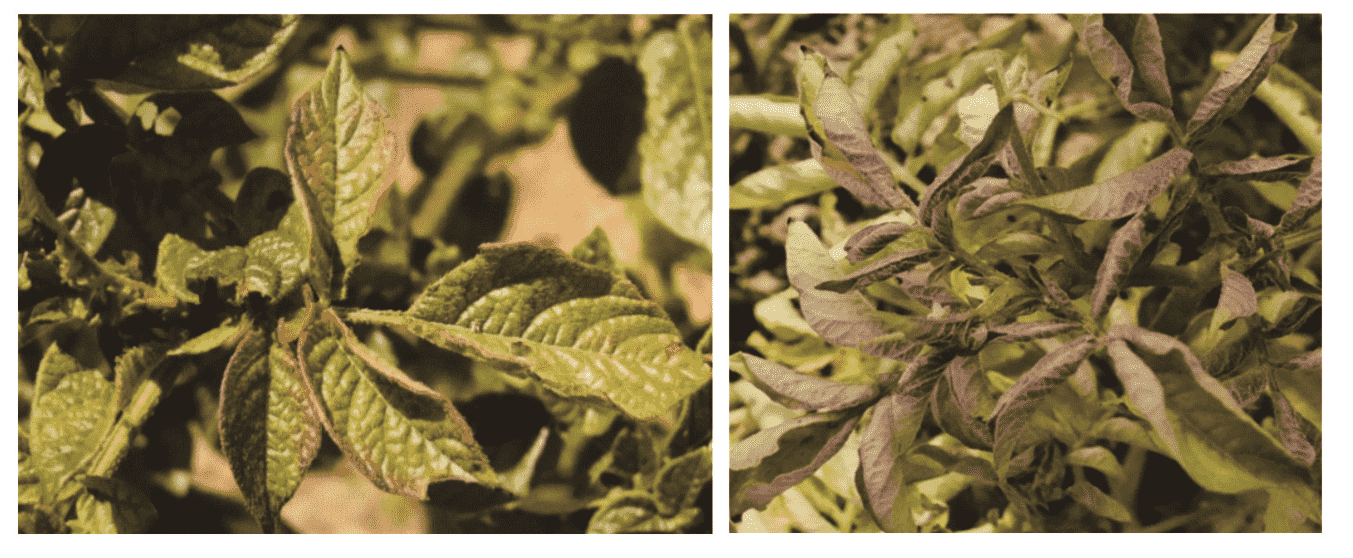
Causes of Phosphorus Deficiency in Potatoes: Phosphorus deficiency often occurs in heavy soils due to the fixation of phosphorus, making it unavailable to plants. In light soils, the natural phosphorus content is low. Additionally, phosphorus deficiency can also result from the consumption of phosphorus by previous crops.
Prevention and Remedies for Phosphorus Deficiency in Potatoes: For prevention and remediation, apply 15-25 kg of superphosphate per acre as a base fertilizer, mixed with organic manure, and incorporate it into the soil to a depth of 10 cm. During the flowering stage, apply 15-20 kg of superphosphate per acre. Foliar sprays can also be used, such as a 0.2%-0.3% solution of monopotassium phosphate or a 0.5%-1% solution of super phosphate.
Symptoms of Potassium Deficiency in Potatoes
Potassium-deficient plants exhibit slow growth, shortened internodes, and rough, wrinkled leaves that curl downward. Leaflets are closely arranged with a small angle between them and the petiole. Leaf tips and edges initially turn dark green, followed by yellowish-brown discoloration that gradually spreads across the entire leaf. Early-stage leaves appear dark green, then turn yellow, and eventually brown. The color change progresses from the leaf tips and edges to the entire leaf. Lower, older leaves develop a bronze hue, become dry, and fall off. The tips and edges of old leaves turn yellow to brown, with necrotic spots appearing along the leaf veins. Tuber interiors often develop gray-blue rings, resulting in poor quality.
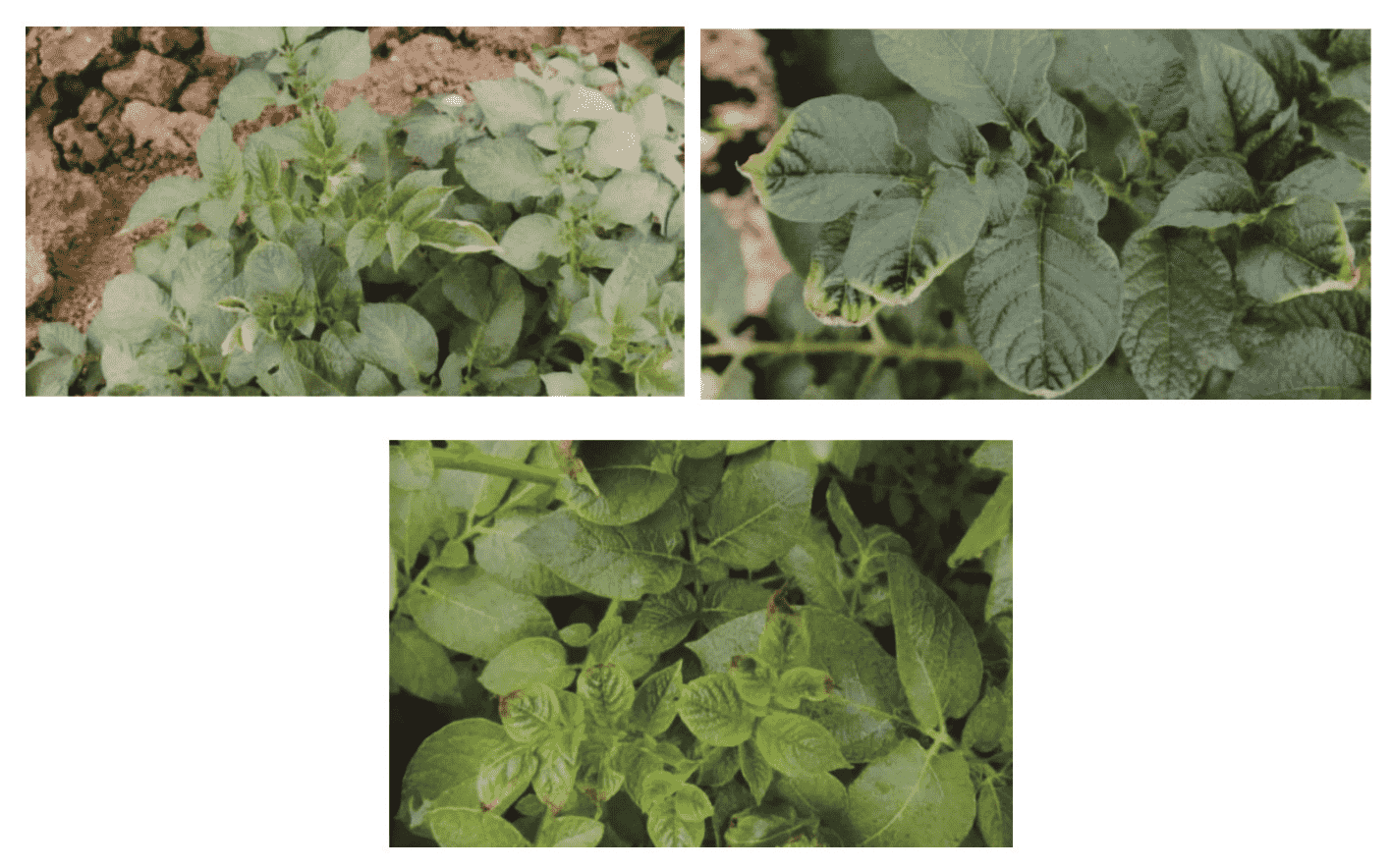
Causes of Potassium Deficiency in Potatoes
Potassium deficiency is common in leached sandy soils, humus soils, and peat soils, which often cannot meet the potassium requirements for potato growth.
Prevention and Correction Measures for Potassium Deficiency
When applying base fertilizers, mix in 200 kg of wood ash. After 40 days of planting, apply a top-dressing fertilizer using 150-200 kg of wood ash or 10 kg of potassium sulfate dissolved in water. Additionally, 40-50 days before harvest, spray a 1% potassium sulfate solution, applying it every 10-15 days for a total of 2-3 applications. Alternatively, you can spray a 0.2%-0.3% mono potassium phosphate solution or 1% wood ash leachate.
Symptoms of Magnesium Deficiency in Potatoes:
When magnesium is deficient, the lower old leaves initially lose their green color at the tips, edges, and between the veins, with the discoloration spreading toward the central parts along the veins. Eventually, the areas between the veins are filled with discolored, necrotic spots. Leaf clusters thicken, and the areas between the veins may bulge outward. The main veins of the leaves exhibit noticeable chlorosis, with colored spots appearing, but tissue necrosis is not common. In the later stages, the lower leaves become brittle and thicker, with the leaf color lightening. In severe cases, the plant becomes stunted, with the lower leaves curling upward, thickening, and eventually turning brown and falling off due to chlorosis. The middle and lower leaves lose their green color, while the veins generally remain green. The leaf tissue turns yellow, resembling rib bones, and may even wither. Root and tuber growth is also inhibited.
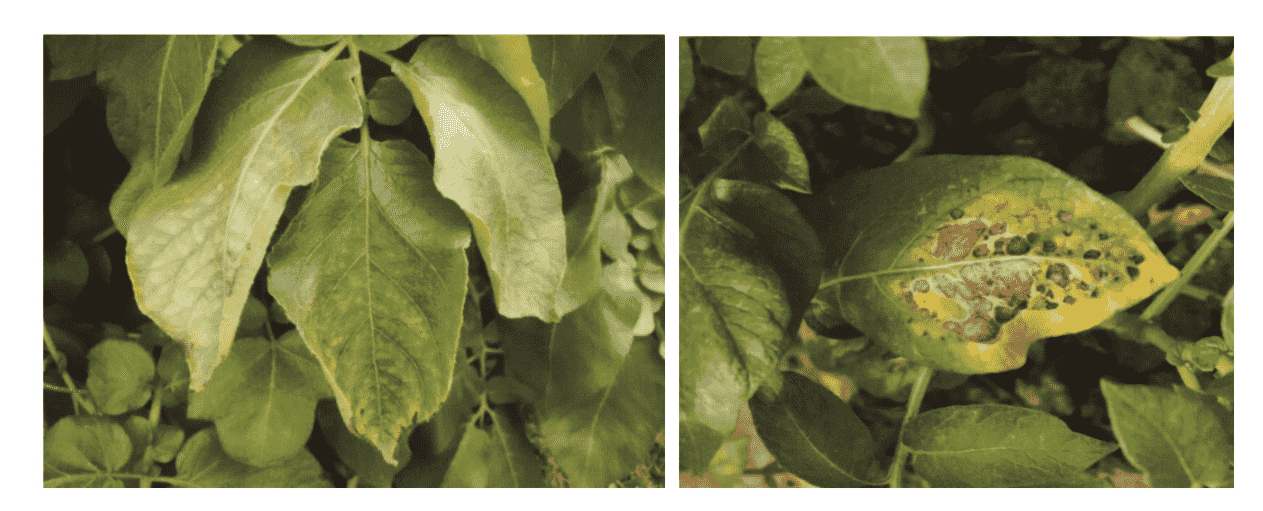
Causes of Magnesium Deficiency in Potatoes:
Magnesium deficiency often occurs in soils with higher acidity. The use of mineral fertilizers containing certain high concentrations of nitrogen nutrients can increase the solubility of magnesium compounds, leading to magnesium deficiency.
Prevention and Remedial Measures for Magnesium Deficiency in Potatoes:
Soil Improvement: Focus on applying well-decomposed organic fertilizer to improve the physical and chemical properties of the soil, maintaining a neutral pH. If necessary, apply lime to adjust the soil pH and avoid excessive acidity or alkalinity.
Balanced Fertilization: Use balanced fertilization techniques, ensuring a proper ratio of nitrogen, phosphorus, potassium, and micronutrients.
Magnesium Supplementation: If soil magnesium levels are insufficient, apply complete fertilizers containing magnesium. In emergencies, spray a 1%-2% magnesium sulfate solution on the leaves, repeating every 2 days for 3-4 applications.
Symptoms of Zinc Deficiency in Potatoes:
When zinc is deficient, plant growth is inhibited, internodes are shortened, and the terminal leaves stand upright. The leaves are small, with irregular gray to bronze spots on the surface, and the leaf edges curl upward. In severe cases, brown spots appear on the petioles and stems. Symptoms are noticeable before flowering, with plants appearing stunted and weak, and the leaves turning pale green, eventually becoming yellow. In the later stages of growth, the edges of the lower leaflets lose chlorophyll completely, becoming wrinkled and shrunken, sometimes appearing scorched. The leaves may also fall off.
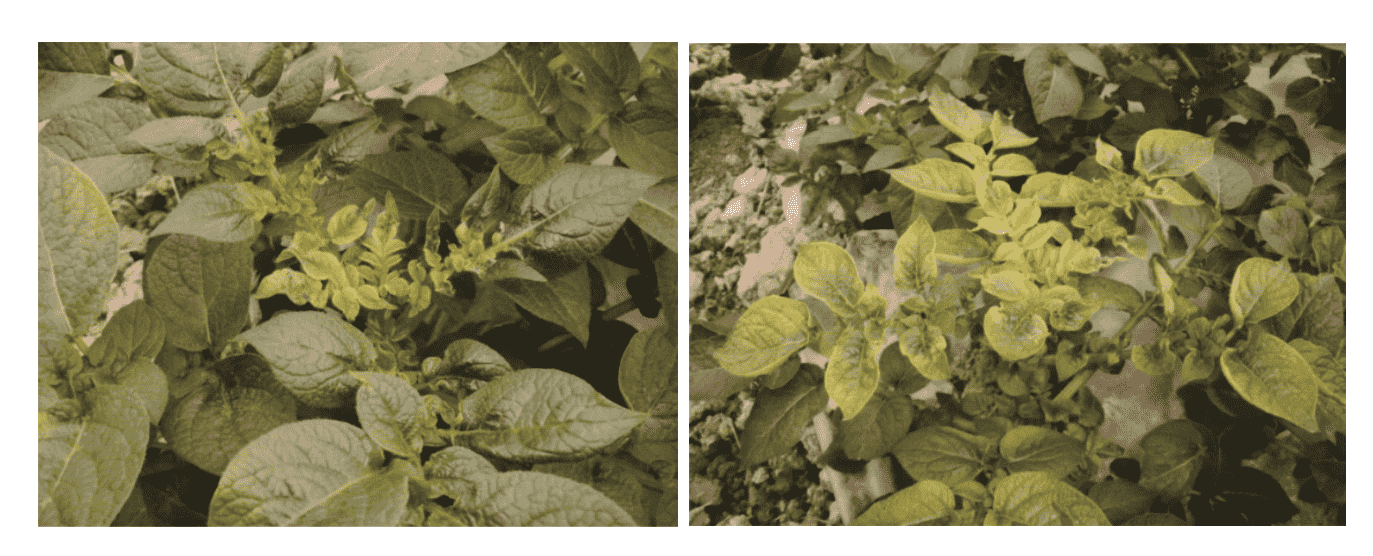
Causes of Zinc Deficiency in Potatoes: Zinc deficiency can occur if the soil itself lacks zinc; or if the soil contains high levels of phosphorus, which inhibits zinc absorption. Additionally, if the soil is alkaline, zinc becomes insoluble and cannot be absorbed by the vegetable roots. Prevention and Remedial Measures for Zinc Deficiency in Potatoes: To avoid soil alkalinity, apply lime in moderation. Before planting, apply 1.0-1.5 kg of zinc sulfate per mu (Chinese unit of area). If zinc deficiency symptoms are observed, spray a 0.1%-0.2% zinc sulfate or zinc chloride solution on the leaves.
Symptoms of Zinc Deficiency in Potatoes:
Zinc deficiency causes stunted growth in plants, with shortened internodes and terminal leaves standing upright. The leaves are small with irregular gray to bronze spots on the surface, and the leaf edges curl upward. In severe cases, brown spots appear on the petioles and stems before flowering. The plants are stunted and weak, with pale green leaves that eventually turn yellow. In the later stages of growth, the edges of the lower leaflets lose chlorophyll completely and become wrinkled.

Causes of Iron Deficiency in Potatoes: Excessive phosphorus fertilizer in the soil or alkaline conditions can affect the absorption and mobility of iron, leading to iron deficiency symptoms.
Prevention and Remedial Measures for Iron Deficiency in Potatoes: To prevent iron deficiency, spray a 0.5%-1% ferrous sulfate solution once or twice at the beginning of the flowering period.
Recommended Fertilizer:
Wistom Fertilizer is a high-quality brand known for its ability to effectively supplement micro nutrients. It provides a comprehensive nutrient formula that addresses various micro nutrient deficiencies, such as zinc and boron. Using Wistom Fertilizer ensures that plants receive balanced nutrition, promoting healthy growth and improving yields.
Post time: Aug-15-2024




